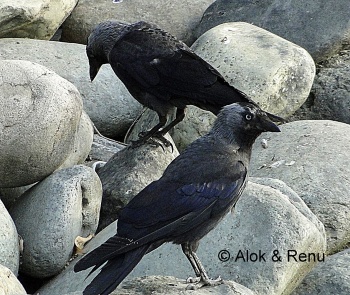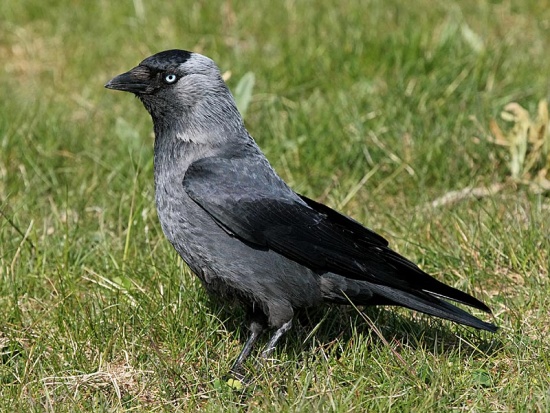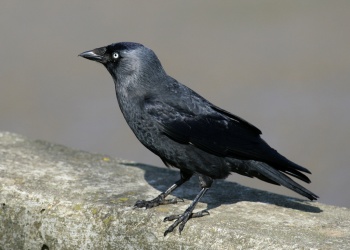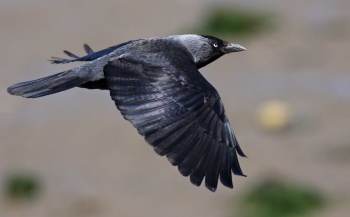(→Breeding: Added note.) |
(Picture of nest. References updated) |
||
| (8 intermediate revisions by 3 users not shown) | |||
| Line 1: | Line 1: | ||
| − | [[Image:Coloeus monedula by Macswede.jpg|thumb|550px|right|''C. m. monedula''<br />Photo | + | [[Image:Coloeus monedula by Macswede.jpg|thumb|550px|right|''C. m. monedula''<br />Photo © {{user|Macswede|Macswede}} <br />Stockholm, [[Sweden]]; May 2007]] |
| + | '''Alternative names: Jackdaw, Western Jackdaw''' | ||
;[[:Category:Corvus|Corvus]] monedula | ;[[:Category:Corvus|Corvus]] monedula | ||
| + | ''Coloeus monedula'' | ||
==Identification== | ==Identification== | ||
| + | [[Image:Coloeus monedula by Mahsleb.jpg|thumb|350px|right|''C. m. spermologus''<br />Photo © by the late '''[https://www.birdforum.net/gallery/showgallery.php/ppuser/50827/cat/500 Mahsleb]''' <br />Mistley, [[Essex]], UK; March 2014]] | ||
34–39 cm (13½-15¼ in) | 34–39 cm (13½-15¼ in) | ||
*Black plumage | *Black plumage | ||
| Line 9: | Line 12: | ||
*Short, pointed bill | *Short, pointed bill | ||
Sexes similar. Juveniles have a dark iris at first, and a softer, tinged-brownish plumage without gloss. | Sexes similar. Juveniles have a dark iris at first, and a softer, tinged-brownish plumage without gloss. | ||
| − | |||
====Similar species==== | ====Similar species==== | ||
Immature [[Daurian Jackdaw]]s look similar to this species, but more solidly black on the head. | Immature [[Daurian Jackdaw]]s look similar to this species, but more solidly black on the head. | ||
==Distribution== | ==Distribution== | ||
| + | [[Image:eurasian_jackdaw_alok.JPG|thumb|350px|right|''C. m. soemmerringii'' Pair<br />Photo © by {{user|aloktewari|Alok Tewari}} <br />Sonamarg, Alt. 9212 ft.(2808 m), [[Kashmir]], [[India]], June-2011]] | ||
Found in most of [[Europe]], patchily in northern [[Africa]], the [[Middle East]] and western and central [[Asia]].<br /> | Found in most of [[Europe]], patchily in northern [[Africa]], the [[Middle East]] and western and central [[Asia]].<br /> | ||
Accidental vagrant to northeastern [[United States]] and [[Canada]]. <br /> | Accidental vagrant to northeastern [[United States]] and [[Canada]]. <br /> | ||
| Line 18: | Line 21: | ||
==Taxonomy== | ==Taxonomy== | ||
====Subspecies==== | ====Subspecies==== | ||
| − | [[Image: | + | [[Image:IMG 4697 1.jpg|thumb|350px|right|''C. m. spermologus''<br />Photo © by the late '''[https://www.birdforum.net/gallery/showgallery.php/ppuser/50827/cat/500 Mahsleb]'''<br />Mistley, Essex, May 2009]] |
This is a [[Dictionary_P-S#P|polytypic]] species, consisting of four subspecies<sup>[[#References|[1]]]</sup>: | This is a [[Dictionary_P-S#P|polytypic]] species, consisting of four subspecies<sup>[[#References|[1]]]</sup>: | ||
*''C. m. monedula'': | *''C. m. monedula'': | ||
| Line 30: | Line 33: | ||
==Habitat== | ==Habitat== | ||
| − | |||
Breeds in large holes in trees, or on cliffs, quarries, and buildings, also parks with open woodlands. Winters in open farmland. | Breeds in large holes in trees, or on cliffs, quarries, and buildings, also parks with open woodlands. Winters in open farmland. | ||
==Behaviour== | ==Behaviour== | ||
| + | [[File:BF Eurasian Jackdaw nest.jpg|thumb|350px|right|Jackdaw Nest<br />Photo © by {{user|nipper1976|nipper1976}}<br />A bell tower, [[Yorkshire]], 17 April, 2023]] | ||
They can form large winter roosts, often along with [[Rook]]s. | They can form large winter roosts, often along with [[Rook]]s. | ||
====Diet==== | ====Diet==== | ||
The diet includes insects, amphibians, rodents, seeds, fruits, berries, reptiles, eggs and young birds. | The diet includes insects, amphibians, rodents, seeds, fruits, berries, reptiles, eggs and young birds. | ||
====Breeding==== | ====Breeding==== | ||
| − | |||
Breeding season starts in late April. Pairs stay together for several years. Usually several pairs are nesting in close proximity on rooftop chimneys, in caves and quarries. The nests are untidy stick structures. Jackdaws are the only corvids which nest in tree cavities, although they will also use crevices in cliffs and buildings. They will use long nest boxes. Lays 3-8 (average 4) eggs. | Breeding season starts in late April. Pairs stay together for several years. Usually several pairs are nesting in close proximity on rooftop chimneys, in caves and quarries. The nests are untidy stick structures. Jackdaws are the only corvids which nest in tree cavities, although they will also use crevices in cliffs and buildings. They will use long nest boxes. Lays 3-8 (average 4) eggs. | ||
====Vocalisation==== | ====Vocalisation==== | ||
'''Call''': a ringing ''kyow'', also ''chiak''. | '''Call''': a ringing ''kyow'', also ''chiak''. | ||
| − | + | {{ Audio|Corvus monedula (song).mp3 }} | |
| − | + | ||
==References== | ==References== | ||
| − | #{{Ref- | + | #{{Ref-Clements6thOct22}}#{{Ref-HBWVol14}}#BF Member observations |
#Madge, S. & Burn, H. (1994) Crows and Jays: A Guide to the Crows, Jays and Magpies of the World. Houghton Mifflin, Boston. | #Madge, S. & Burn, H. (1994) Crows and Jays: A Guide to the Crows, Jays and Magpies of the World. Houghton Mifflin, Boston. | ||
#Whatbird | #Whatbird | ||
| Line 51: | Line 53: | ||
==External Links== | ==External Links== | ||
| − | {{GSearch|Corvus | + | {{GSearch|"Corvus monedula" {{!}} "Coloeus monedula" {{!}} "Eurasian Jackdaw" {{!}} "Western Jackdaw"}} |
| − | + | {{GS-checked}}1 | |
| − | {{ | ||
<br /> | <br /> | ||
| − | |||
<br /> | <br /> | ||
| − | |||
| − | [[Category:Birds]][[Category:Corvus]][[Category:Bird Songs | + | [[Category:Birds]][[Category:Corvus]][[Category:Bird Songs]] [[Category:Coloeus]] |
Latest revision as of 22:47, 11 May 2023
Alternative names: Jackdaw, Western Jackdaw
- Corvus monedula
Coloeus monedula
Identification
34–39 cm (13½-15¼ in)
- Black plumage
- Blue-black metallic sheen on back and shoulders
- Grey nape and ear patches; paler grey in eastern subspecies
- Pale blue-green iris
- Short, pointed bill
Sexes similar. Juveniles have a dark iris at first, and a softer, tinged-brownish plumage without gloss.
Similar species
Immature Daurian Jackdaws look similar to this species, but more solidly black on the head.
Distribution

Photo © by Alok Tewari
Sonamarg, Alt. 9212 ft.(2808 m), Kashmir, India, June-2011
Found in most of Europe, patchily in northern Africa, the Middle East and western and central Asia.
Accidental vagrant to northeastern United States and Canada.
Abundant in most of its range; populations decreased in most western European countries in the past but have now mostly recovered.
Taxonomy
Subspecies
This is a polytypic species, consisting of four subspecies[1]:
- C. m. monedula:
- Scandinavia; occasionally winters to England and France
- C. m. spermologus:
- Western and central Europe, including the British Isles, and Morocco and northwestern Algeria
- C. m. soemmerringii:
- C. m. cirtensis:
Habitat
Breeds in large holes in trees, or on cliffs, quarries, and buildings, also parks with open woodlands. Winters in open farmland.
Behaviour
They can form large winter roosts, often along with Rooks.
Diet
The diet includes insects, amphibians, rodents, seeds, fruits, berries, reptiles, eggs and young birds.
Breeding
Breeding season starts in late April. Pairs stay together for several years. Usually several pairs are nesting in close proximity on rooftop chimneys, in caves and quarries. The nests are untidy stick structures. Jackdaws are the only corvids which nest in tree cavities, although they will also use crevices in cliffs and buildings. They will use long nest boxes. Lays 3-8 (average 4) eggs.
Vocalisation
Call: a ringing kyow, also chiak.
References
- Clements, J. F., T. S. Schulenberg, M. J. Iliff, T. A. Fredericks, J. A. Gerbracht, D. Lepage, S. M. Billerman, B. L. Sullivan, and C. L. Wood. 2022. The eBird/Clements checklist of Birds of the World: v2022. Downloaded from https://www.birds.cornell.edu/clementschecklist/download/
- Del Hoyo, J, A Elliott, and D Christie, eds. 2009. Handbook of the Birds of the World. Volume 14: Bush-shrikes to Old World Sparrows. Barcelona: Lynx Edicions. ISBN 978-8496553507
- BF Member observations
- Madge, S. & Burn, H. (1994) Crows and Jays: A Guide to the Crows, Jays and Magpies of the World. Houghton Mifflin, Boston.
- Whatbird
Recommended Citation
- BirdForum Opus contributors. (2025) Eurasian Jackdaw. In: BirdForum, the forum for wild birds and birding. Retrieved 11 May 2025 from https://www.birdforum.net/opus/Eurasian_Jackdaw
External Links
GSearch checked for 2020 platform.1







